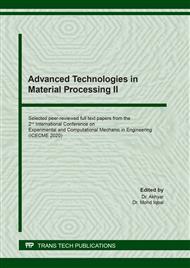[1]
M. Catauro, F. Bollino, F. Papale, S. Marciano, S. Pacifico. Mater. Sci. Eng. C 47 (2015)135-141.
Google Scholar
[2]
H. Jia, J. Cao, Y. Lu, Curr. Opin. Green Sustain. Chem. 4 (2017) 16-22.
Google Scholar
[3]
X. Tian, L. Zhang, M. Yang, L. Bai, Y. Dai, Z. Yu, Y. Pan. Rev. Nanomed. Nanobiotechnol., 10 (2018) e1476.
Google Scholar
[4]
P. Jittabut, Energy Procedia. 79 (2015) 10-17.
Google Scholar
[5]
W. Chuang, J. Geng-sheng, P. Lei, Z. Bao-Iin, L. Ke-zhi, W. Jun-long, Result Phys., 9 (2028) 886-896.
Google Scholar
[6]
C.H. Lee, S.H. Park, W. Chung, J.Y. Kim, S.H. Kim, Colloids Surf. A Physicochem. 384 (2011) 318-322.
Google Scholar
[7]
T.M. Budnyak, L.V. Pylypchuk, V.A. Tertykh, E.S. Yanovska, D. Kolodynska. Nanoscale Res. Lett. 10 (2015) 1-10.
DOI: 10.1186/s11671-014-0722-1
Google Scholar
[8]
F. Zarlaida, M. Adlim, M.S. Surbakti, A.F Omar. Conf. Ser.: Mater. Sci. Eng. 352 (2028) 012049.
DOI: 10.1088/1757-899x/352/1/012049
Google Scholar
[9]
L.A.M Van Den Broek, R.J.I. Knoop, F.H.I. Kappen, C. G. Boeriu. Carbohydr. Polym. 116 (2015) 237-242.
Google Scholar
[10]
N. Mati-Baouche, P. H. Elchinger, H. De Baynast, G. Pierre, C. Delattre, P. Michaud. Eur. Carbohydr. J. 60 (2014) 192-212.
DOI: 10.1016/j.eurpolymj.2014.09.008
Google Scholar
[11]
S. Bashir, Y. Y. Teo, S. Ramesh, K. Ramesh, A.A. Khan, Review Chem. Eng. 31 (2015) 563-597.
Google Scholar
[12]
Q.L. Feng, J. Wu, G.Q. Chen, F.Z. Cui, T.N. Kim, J.O. Kim. J. Biomed 52 (2000) 662-668.
Google Scholar
[13]
M. Adlim, F. Zarlaida, I. Khaldun, R. Dewi, S. Karina, A.F. Omar. Indones. J. Chem. 2 (2019) 386-394.
Google Scholar
[14]
M Adlim, F Zarlaida, RFI Rahmayani, R Wardani. Inviron. Technol. Innov. 16 (2019) 100442.
Google Scholar
[15]
M Adlim, S Karina, F Zarlaida, I Khaldun, N A Fadila, NHHA Bakar, Environ. Technol. Innov. 13 (2019) 74-81.
DOI: 10.1016/j.eti.2018.10.011
Google Scholar
[16]
Z. Weiwei, M. Zhipeng, W. Yazhe, C. Ying, Y. Endong, G. Feng, S. Dongdong, W. Weiyun. Mater. Sci. Eng. C 97 (2019) 486-497.
Google Scholar
[17]
N. Chen, Y. Zheng, J. Yin, X. Lia, C. Zheng. J. Virology Methods 193(2013) v470.
Google Scholar
[18]
A.T. Hang, B. Tae, J.S. Park. Carbohydr. Polym. 82 (2020) 472-479.
Google Scholar
[19]
F. Zarlaida, M. Adlim, Microchim Acta 184 (2017) 45-58.
Google Scholar
[20]
F.M. Reicha, A. Sarhan, M.I. Abdel-Hamid, I.M. El-Sherbiny. Carbohydr. Polym. 89 (2012) 236-244.
Google Scholar
[21]
A. Regiel, S. Irusta, A. Kyziol, M. Arruebo, J. Santamaria. Nanothecnology 24 (2013) 15101.
Google Scholar
[22]
P. Raveendran, J. Fu, S.L. Wallen. Green Chem. 8 (2006) 34-38.
Google Scholar
[23]
Y.K. Twu, Y.W. Chen, C.M. Shih. Powder Technology 185 (2008) 251-257.
Google Scholar
[24]
A. Adlim. Jurnal Sains dan Teknologi 12 (2006) 185-191.
Google Scholar
[25]
P. Cazon, G. Velazquez, J.A. Ramírez, M.Vázquez, Food Hydrocolloids 68 (2017) 136-148.
Google Scholar
[26]
I. Aranaz, C. Castro, A. Heras, N. Acosta, Biomimetics 3 (2018) 21.
Google Scholar
[27]
A. Adlim, M.A. Bakar. Indo. J. Chem. 8 (2008) 184-188.
Google Scholar
[28]
A. Adlim, M.A. Bakar. Indo. J. Chem. 8 (2008) 320-326.
Google Scholar
[29]
U. Siripatrawan U, W. Vitchayakitti. Food Hydrocolloids 61 (2016) 695-702.
Google Scholar
[30]
G. Gnana Kumar, B. Karunagaran, K.S. Nahm, N. Elizabeth. Nanoscale Res. Lett. 4 (2009). 452-458.
Google Scholar
[31]
D.V. Quang, P.B. Sarawade, A. Hilonga, J.-K. Kim, Y.G. Chai, S.H. Kim, J.-Y. Ryu, H.T. Kim. Colloids Surf. A. 389 (2011) 118-126.
DOI: 10.1016/j.colsurfa.2011.08.042
Google Scholar
[32]
P. Pavoski, D.L.S. Baldisserotto, T. Maraschin, L.F.W. Brum, C. dos Santos, J. Henrique, Z. dos Santos, A. Brandelli, G. B. Galland. Eur. Polym. J. 117 (2019) 38-54.
DOI: 10.1016/j.eurpolymj.2019.04.055
Google Scholar


